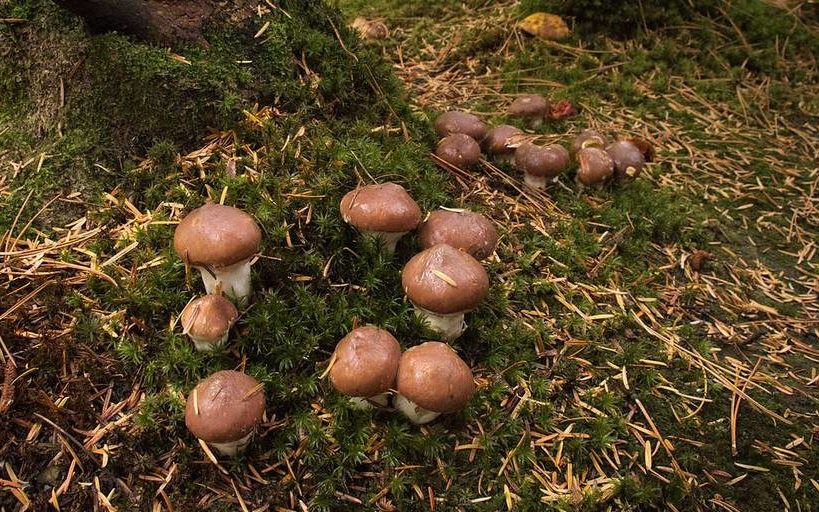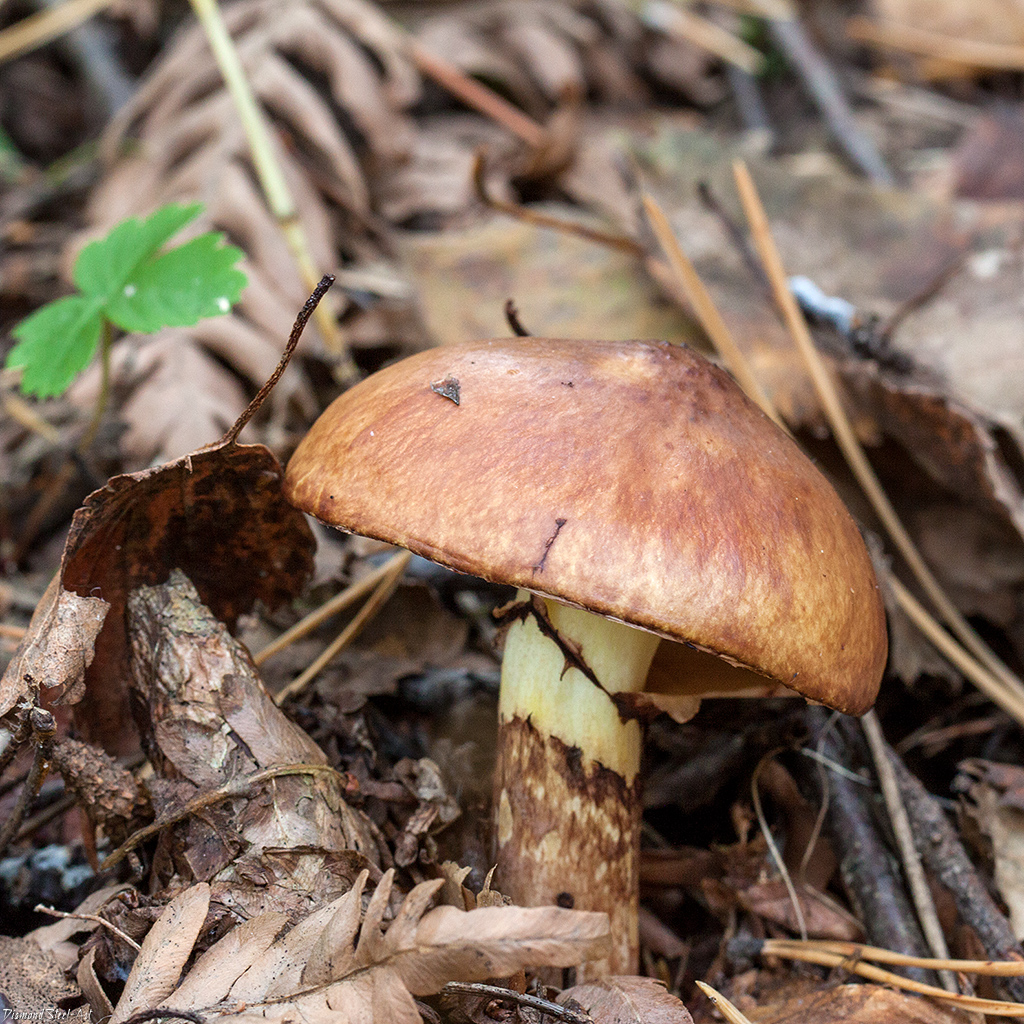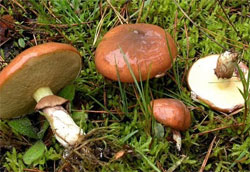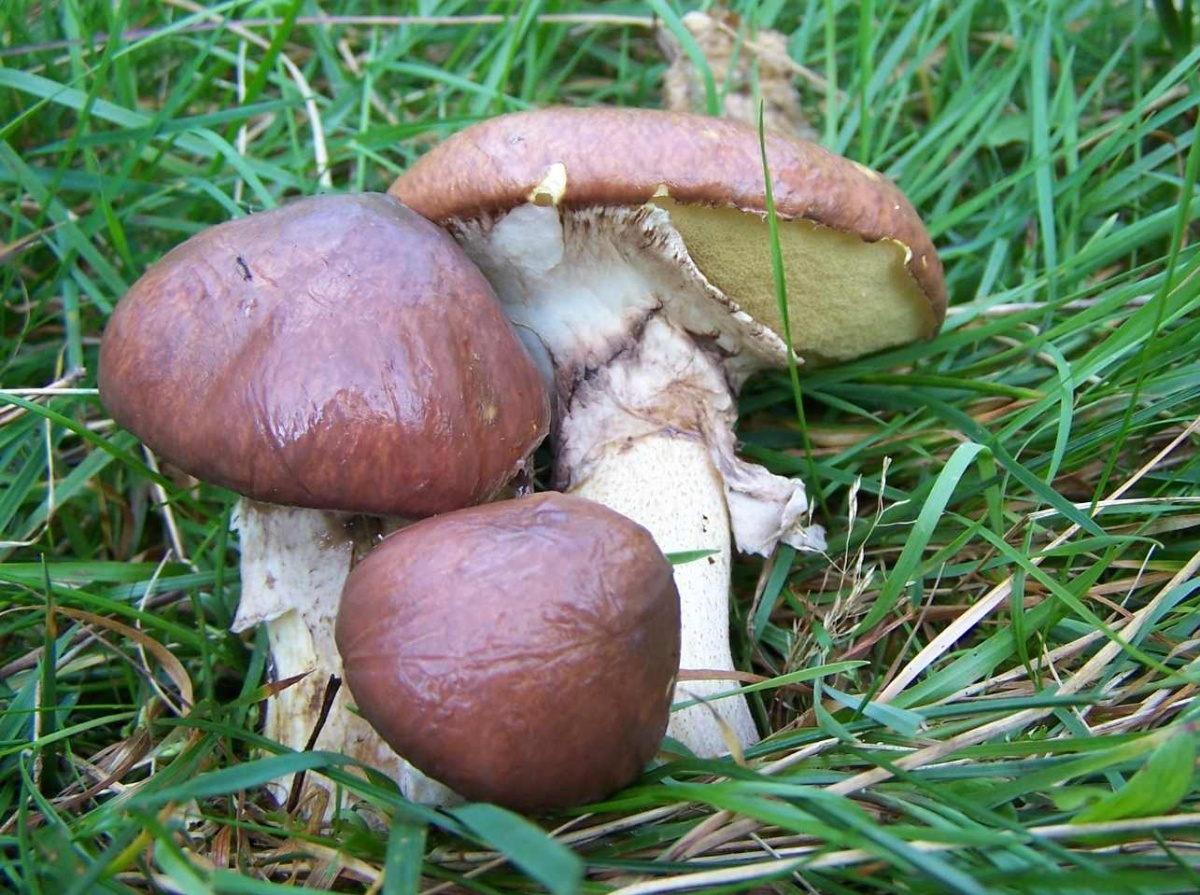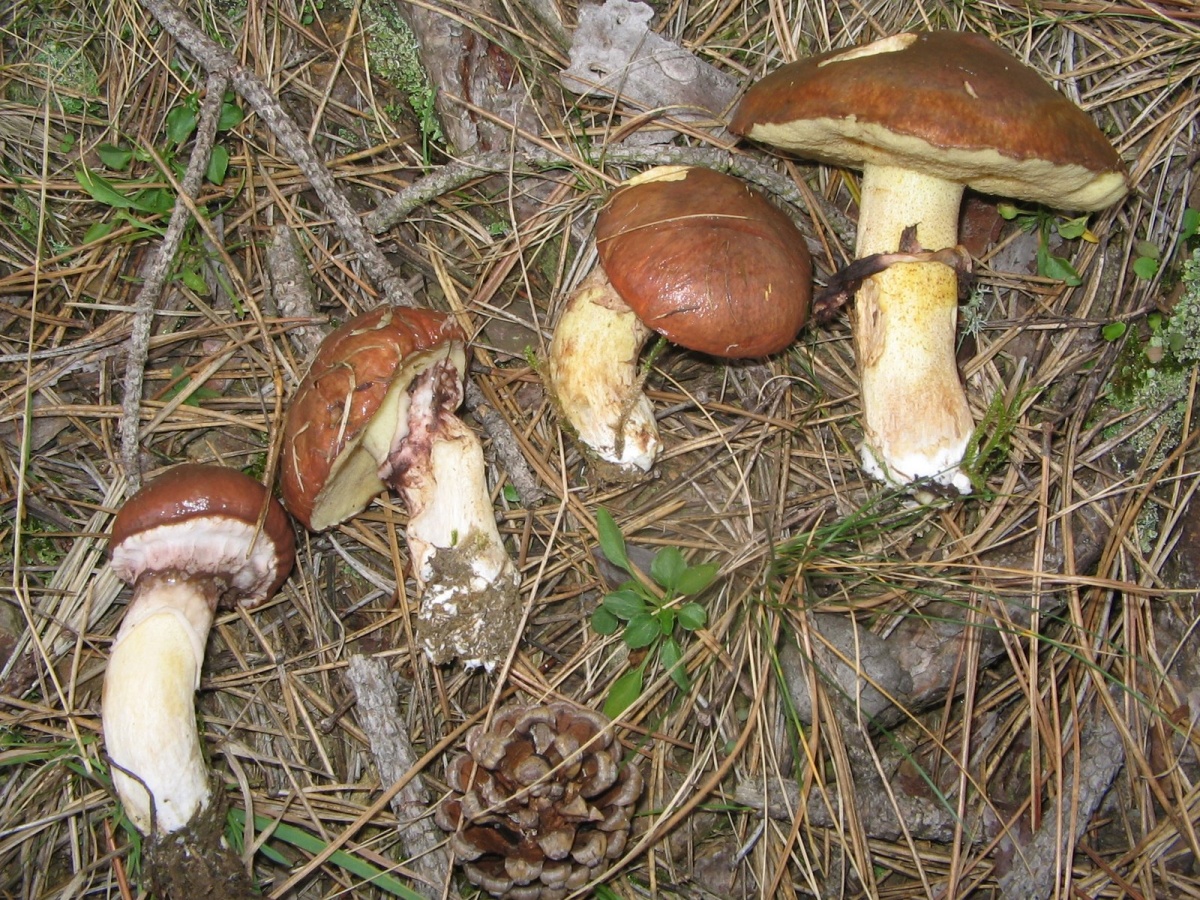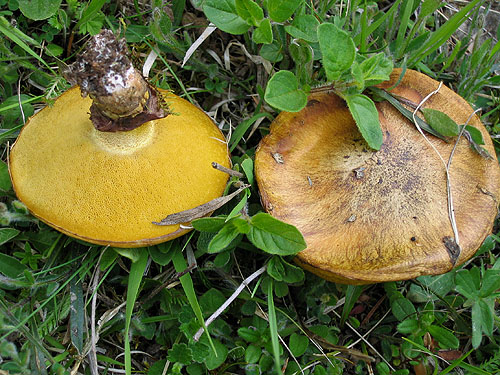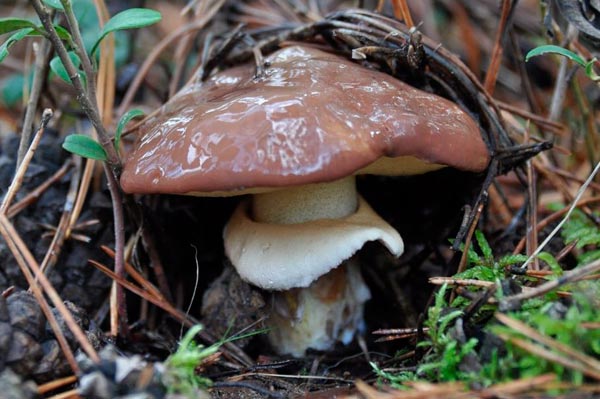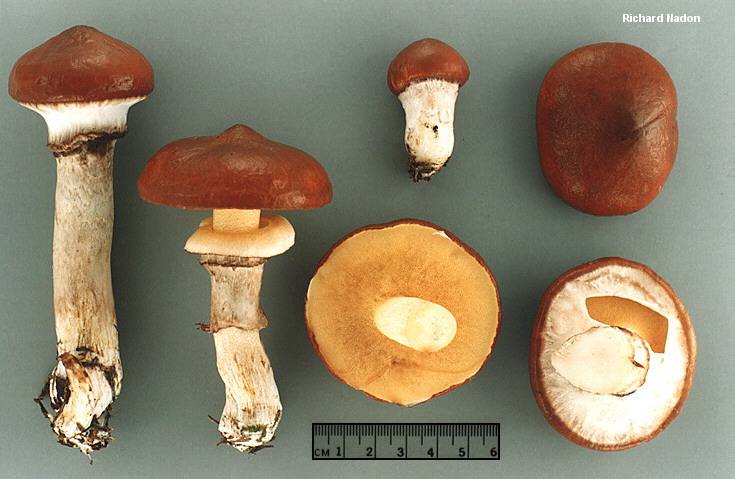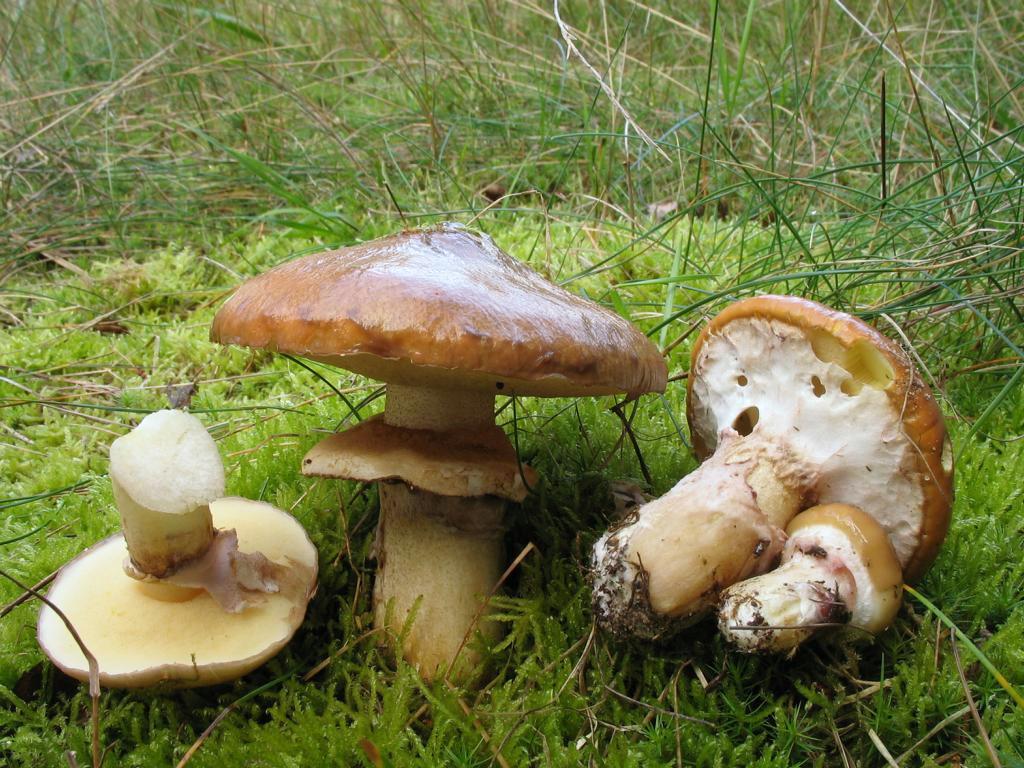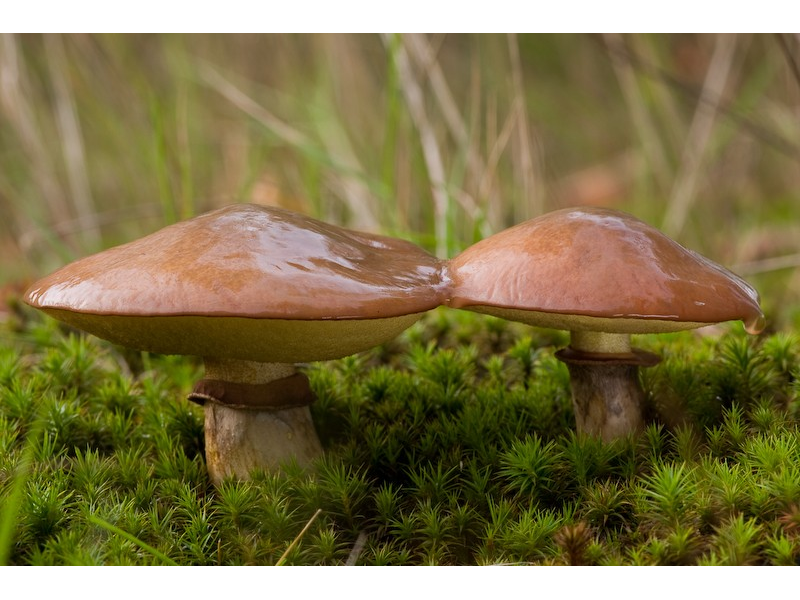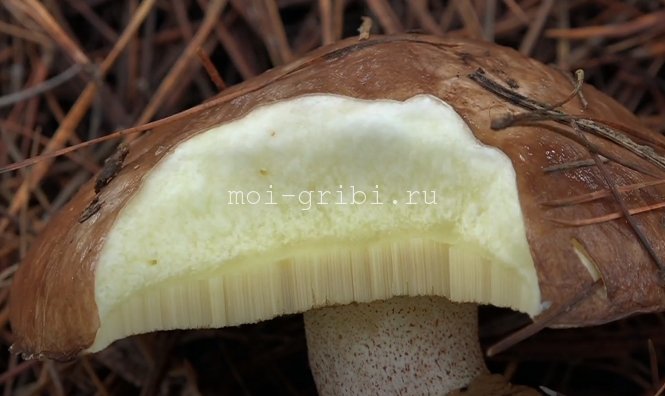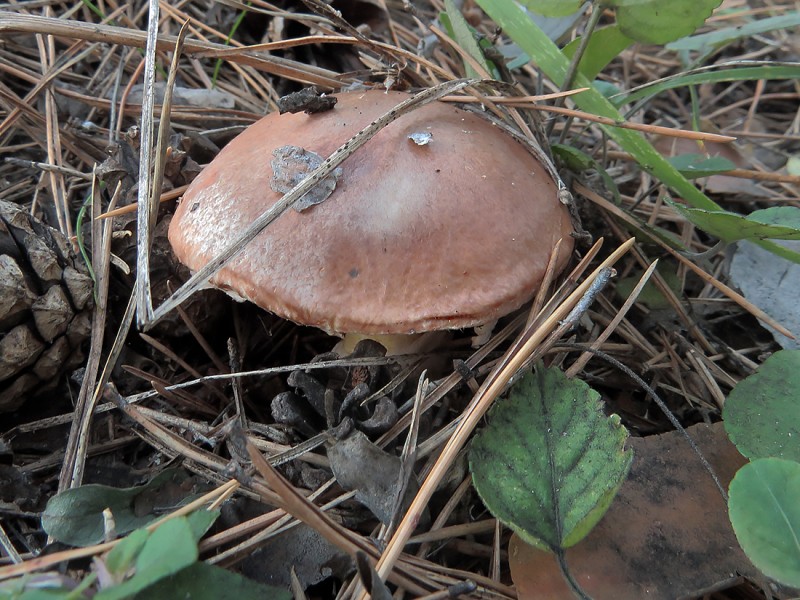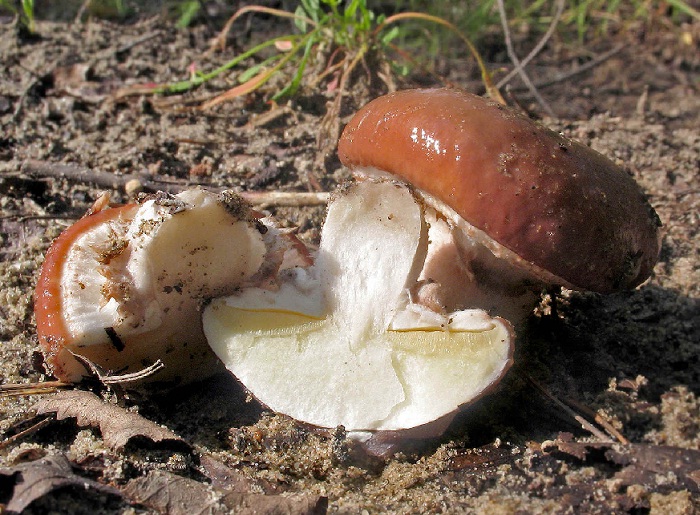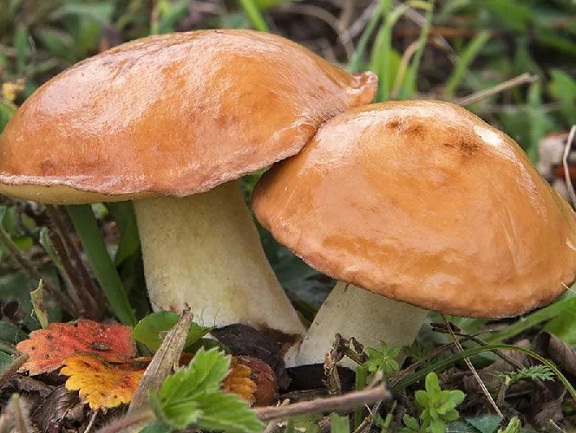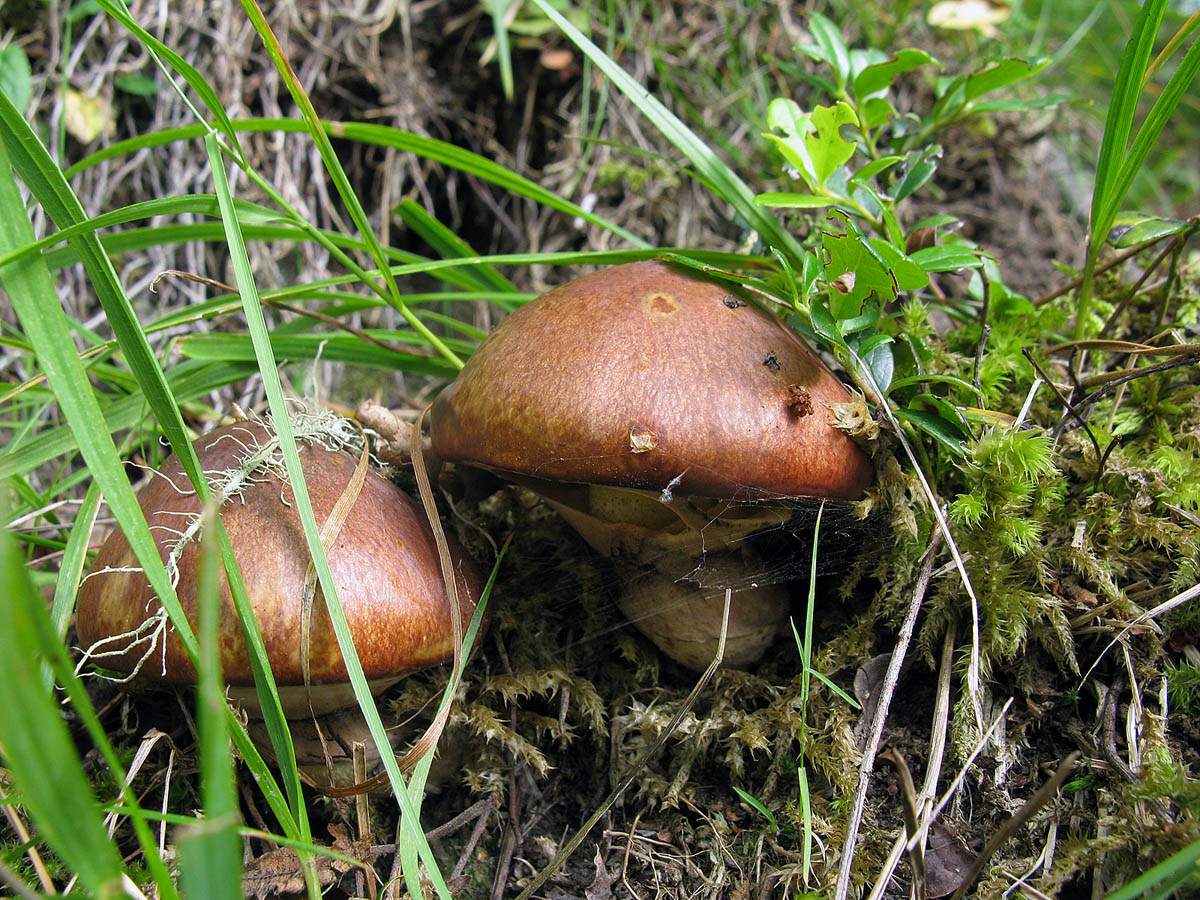Butter dish (Suillus luteus)
- Other names for the mushroom:
- Real butter dish
- Butter dish yellow
- Late butter dish
- Autumn butter dish
Synonyms:
- Boletus luteus
- Boletopsis lutea
Butter dish (Suillus luteus) is the scientific name for the most common type of butter oil. The word luteus in the scientific name of the mushroom means "yellow".
Growth:
Oily can grow on sandy soil from late May to November in coniferous forests. Fruiting bodies appear singly or most often in large groups.
External description
Hat:
The cap of the present Oily (Suillus luteus) reaches a diameter of up to 10 cm, convex, later almost flat with a tubercle in the middle, sometimes with upward curved edges, chocolate-brownish, sometimes with a purple tint. The skin is radially fibrous, very slimy and easily separated from the pulp. The tubules are initially pale yellow, later dark yellow, adherent to the peduncle, 6-14 mm long. The pores are small, in young mushrooms pale yellow, later bright yellow, brownish yellow. Tubular layer adherent to the pedicle, yellow, the pores are at first whitish or pale yellow, then yellow or dark yellow, small, rounded.
Leg:
Cylindrical, solid, 35-110 mm high and 10-25 mm thick, lemon-yellow at the top, brownish and longitudinally fibrous at the bottom. A white filmy blanket, which first connects the leg to the edge of the cap, leaves pieces on the leg in the form of a black-brown or purple ring. Above the ring, the leg is mealy.
Pulp:
The cap is soft, juicy, slightly fibrous at the stem, whitish at first, later lemon-yellow, rusty-brownish at the base of the stem.
Spore powder:
Brown.
Spores: 7-10 x 3-3.5 µm, ellipsoid-fusiform, smooth, pale yellow.
Similarity
The red oiler (Suillus fluryi) is very similar to the Oily can, which is distinguished by the absence of a ring on the leg. It has no resemblance to poisonous mushrooms.
Use
Common butter dish - Edible, tasty mushroom of the second category, in taste, it is very close to porcini mushrooms. It is better to remove the skin from the cap before use. It is consumed dried, fresh, pickled and salted. Delicious and easily digestible mushroom. Suitable for preparing soups, sauces and side dishes for meat dishes. To be pickled.
Spreading
The optimum average daily temperature for fruiting the oiler is + 15 ... + 18 ° C, but the ordinary oiler does not react strongly to temperature fluctuations. Fruiting bodies of boletus usually appear 2-3 days after rain, and strong dew also stimulates fruiting. In mountainous areas, boletus can grow massively around stones, this is due to the condensation of moisture on the surface of the stone. Fruiting ceases at a temperature of -5 ° C on the surface of the soil, and after freezing of the upper layer by 2-3 cm, it does not resume. In the summer (at the beginning of the season) boletus is often damaged by insect larvae, sometimes the proportion of unsuitable "wormy" boletus reaches 70-80%. In autumn, insect activity decreases sharply.
The common oiler is widespread in the Northern Hemisphere, prefers a moderately cold climate, but is also found in the subtropics, sometimes it is accidentally introduced by humans into tropical regions, where it forms local populations in artificial pine plantations.
In Russia, boletus is widespread in the European part, in the North Caucasus, in Siberia, in the Far East. Fruiting more often in large groups.
Season June - October, massively from September.
Features of the mushroom:
Boletus edulis (boletus) are ahead of boletus edulis in terms of the content of fats and carbohydrates. Common butter dish - One of the most common types of edible mushrooms, it takes first place in its yield in coniferous forests.
Definitioner
- Basidia (Basidia)
-
Lat. Basidia. A specialized structure of sexual reproduction in fungi, inherent only in Basidiomycetes.Basidia are terminal (end) elements of hyphae of various shapes and sizes, on which spores develop exogenously (outside).
Basidia are diverse in structure and method of attachment to hyphae.
According to the position relative to the axis of the hypha, to which they are attached, three types of basidia are distinguished:
Apical basidia are formed from the terminal cell of the hypha and are located parallel to its axis.
Pleurobasidia are formed from lateral processes and are located perpendicular to the axis of the hypha, which continues to grow and can form new processes with basidia.
Subasidia are formed from a lateral process, turned perpendicular to the axis of the hypha, which, after the formation of one basidium, stops its growth.
Based on morphology:
Holobasidia - unicellular basidia, not divided by septa (see Fig. A, D.).
Phragmobasidia are divided by transverse or vertical septa, usually into four cells (see Fig. B, C).
By type of development:
Heterobasidia consists of two parts - hypobasidia and epibasidia developing from it, with or without partitions (see Fig. C, B) (see Fig. D).
Homobasidia is not divided into hypo- and epibasidia and in all cases is considered holobasidia (Fig. A).
Basidia is the place of karyogamy, meiosis and the formation of basidiospores. Homobasidia, as a rule, is not functionally divided, and meiosis follows karyogamy in it. However, basidia can be divided into probasidia - the site of karyogamy and metabasidia - the site of meiosis. Probasidium is often a dormant spore, for example in rust fungi. In such cases, probazidia grows with metabasidia, in which meiosis occurs and on which basidiospores are formed (see Fig. E).
See Karyogamy, Meiosis, Gifa.
- Pileipellis
-
Lat. Pileipellis, skin - differentiated surface layer of the cap of agaricoid basidiomycetes. The structure of the skin in most cases differs from the inner flesh of the cap and may have a different structure. The structural features of pileipellis are often used as diagnostic features in descriptions of fungi species.
According to their structure, they are divided into four main types: cutis, trichoderma, hymeniderma and epithelium.
See Agaricoid fungi, Basidiomycete, Cutis, Trichoderma, Gimeniderm, Epithelium.
Common butter dish (autumn, late, yellow, real, Suillus luteus): what they look like, when to collect, how to cook
| + |
|
Real butter dish, late (Suillus luteus) Synonyms - yellow oil can, autumn oil can
By growing time Suillus luteus not so “late” - it appears already in the summer. You can get on the “wave” of a real butter dish until the end of October. Entering a coniferous forest (usually young pine), confuse Suillus luteus with any other mushroom is not easy enough. And all because the shiny round hats peeking out of the ground will leave no choice - this is it! In a mixed forest, spruce moss can sparkle with a slimy skin, but the similarity with boletus ends there: you just have to turn the mushroom over and see the descending plates. However, if a completely visually impaired mushroom picker and an inexperienced one picks up spruce moss instead of butter, nothing threatens his stomach. The Real Oiler has no poisonous counterparts.
Often to the hat Suillus luteus needles and leaves stick, masking small fruiting bodies. And, sitting down for one group of butter, while cutting them off, you will surely see more and more “families”. The most important thing is not to lose your cool and look through every mushroom due to their frequent worminess.
The hat of the Late Oiler is from beige to dark brown, the hymenophore is tubular, bright yellow, in young specimens covered with a dense white film. This "skirt" features Suillus luteus from the closest relatives - granular oils, devoid of any kind of cover, and from larch oils, which have a yellowish cover (however, they also have a painted leg) Mucous skin covering the surface of the cap Suillus luteus, can be easily removed and a velvety surface can be seen underneath.Whether it is necessary to peel off the skin before cooking is another topic that has been argued and will be arguing) When processing these mushrooms, it is enough to boil these mushrooms twice for 5-7 minutes in boiling water with double rinsing with cold water to remove mucus. Aesthetes prefer cleaning, assuring that the cuticle affects the taste. Butterlets Late usually do not grow tall and remain stocky even into adulthood. The leg is from 3 to 5 cm, dense, without cavities. Spore powder of yellow color. In the cut, the flesh has a yellowish tint, does not darken during cooking, which makes these small pain mushrooms especially attractive in the marinade! Suillus luteus according to nutritional value, they are assigned to category 2.
Very fragrant mushrooms, when frying, an incredible mushroom smell spreads in the air. Butterlets Late, like all other boletus, can be eaten without prior boiling. These versatile mushrooms are suitable for drying (they dry for a long time due to their high humidity) and for soups, they are tasty and fried with potatoes and sour cream, and marinated with butter, and salted with onions!
More photos on our photos site
Worked on the description Podzvezdami, thanks her!
Dry butter dish (Suillus bovinus)
- Other names for the mushroom:
- Goat
- Goat mushroom
- Cow mushroom
Synonyms:
- Reshetnyak
- Cow
- Cow mushroom
- Mullein
Dry butter dish (Latin Suillus bovinus) is a tubular mushroom of the genus Butter dish of the order Boletovye.
Spreading:
Dry oiler (Suillus bovinus) grows in pine and spruce forests in July - September. Distributed mainly in areas with a temperate climate. It has a characteristic cap, usually slightly slimy and sticky, in comparison with other types of butter. Buttercup is dry, like all boletus, a mycorrhizal forming agent, grows with conifers (usually pine). Most often found on sandy soils, especially abundant in young artificial pine plantations. After heavy torrential rains, they appear in large groups, which pleases, especially in the absence of other mushrooms.
Description:
The dry oiler looks like a flywheel, only its cap is very convex, covered with brown skin on top, slightly sticky. Rusty tubular layer, does not separate from the cap. The leg is the same color as the hat. The pulp is yellowish, slightly reddens at the break.
Note: Dry oiler is the record holder for worminess. A common picture is a carpet of Oily cans on the forest floor, but there is practically nothing to take. And even if, after cutting off the mushroom, we see a clean cut, this does not mean that the cap is clean. In half the cases, it will turn out to be wormy. Therefore, after checking a dozen or two Oily can dry for worminess, you are completely disappointed in them and stop collecting altogether.
Drying The oiler is dry: wipe the young, undamaged mushrooms dry with a cloth. It is imperative to cut the cap - it is she who happens to be inside the worm-like without any other signs of damage. You do not need to wash, as mushrooms do not dry well. On hot days, the grates can be dried in the sun, having previously strung them on a string. In inclement weather, this procedure is performed in ovens. The temperature in them should not exceed 70 degrees. A prerequisite for drying is the supply of fresh air, which helps to remove the moisture released by the mushrooms. Mushroom powder can be easily prepared from the resulting raw materials. It is simply ground in an ordinary coffee grinder or pounded in a mortar. The mushroom powder obtained in this way is very good for dressing meat, rice dishes and sauces. Usually, the aroma of mushrooms increases during drying, so the powder is put in minimal doses.
Mushrooms that look like boletus (false)
Mushrooms similar to boletus are conditionally edible. They taste bitter and upset the gastrointestinal tract, but do not lead to fatal consequences after consumption. False boletus rarely comes across mushroom pickers and have insignificant external differences from real edible mushrooms. Doubles:
Pepper oiler
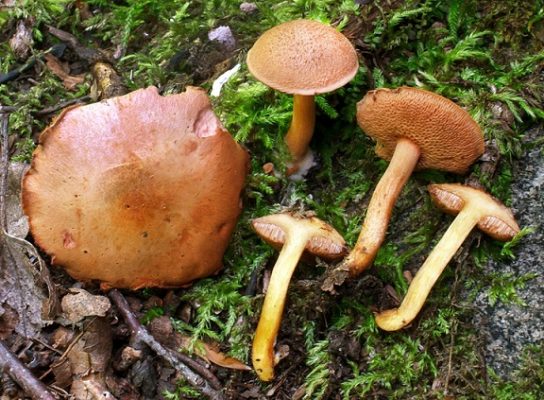
Siberian butterdish

Goat

When you look at mushrooms, it seems that it is impossible to distinguish between false and edible boletus, but if you look closely, it is not so. Conditionally edible mushrooms have a purple-tinged cap and a gray film. A real oiler has a white film. The place of damage to the inedible mushroom turns yellow.
The twins are thoroughly cleaned and treated with high temperatures at least twice, only after that they are eaten. However, the Siberian butterdish retains its bitterness regardless of the number of cooking cycles.
Late Butter - Suillus luteus
Written by Nikolay Budnik and Elena Meck.
Late butter dish (real, ordinary) is named so because of the hat, as if smeared with butter. The fungus is usually found in young dry pine forests, on the edges, on the sides of forest roads.
Butterlets grow in large groups, but sometimes you will take one out of ten, because the rest are wormy. Therefore, late Butterlets are appreciated, when it gets cooler and there are much fewer insects.
Butterlets may appear in June, or may appear in October, although most often in early September. Be very careful when collecting Butterlets because these mushrooms tend to self-heat in a basket or bucket. Under the influence of high temperature, Butterlets lose their taste and become unsuitable for food.
Previously, there were a lot of Butterlets on our site, because the pines on it were small. And now the pines have grown, and there are much fewer Butterlets.
Butter can have a wonderful aroma in dried form, although there are authors who claim that the Butter is not dried, as it supposedly becomes "glassy" and does not soak. We know from childhood that dried Butter is great.
1. Late butter dish is a wonderful mushroom.
2. Its skin, especially in wet weather, is smooth and shiny.
3. She seems to be covered with oil.
4. That is why the oiler is called that way.
5. Only caps often stick out of the forest floor.
6. But it happens that you can see the leg.
7. Late butterflies sometimes just overlap each other.
8. Mushrooms hardly grow alone.
9. There are groups, rows, families.
10. Even if you see one butter dish, be sure to look around.
11. And sometimes you don't even need to look.
12. Several or even dozens of mushrooms are immediately visible.
13. Late Butter loves dry pine forests.
13a. Sometimes it is more a field than a forest.
14. Mushrooms prefer young woods.
15. They can also be found among the green grass.
16. . and among the white moss.
17.. and on a forest floor of needles and leaves.
18. Still, mushrooms prefer dry pine young growth.
19. And these gigantic boletus grew in a spruce forest.
20. In the forest, boletus grows juicy and strong.
21. They have a thick leg and a juicy hat.
22. And these mushrooms are just gigantic in size.
23. In the shade of the forest, boletus are quite large and high.
24. But in the open, they are smaller and squat.
25. These boletus are already ending their life path.
26. And this mushroom is the same size of the cap, but still quite young.
27. Look at the huge hat of a late oiler that grew up in the forest.
28. In dry open places, mushroom caps are much smaller.
29. Usually they are almost round.
30. The edges of the caps of young mushrooms are bent inward.
31. Gradually the hat straightens out. Its edges become slightly wavy.
32. The color of the cap varies from reddish brown to ocher, sometimes with a darker center.
33. In dry weather, radial darker streaks are noticeable on the cap.
34. The tubules of the late oiler are initially completely covered with a filmy private veil.
35. Then the veil falls off.
36. The tubular layer becomes visible.
37. At first, the pores are very small and light.
38. In old mushrooms, they become larger, friable and darker.
39. The leg is almost straight.
40. It is very light, almost white.
41. Then the coverlet remains on the leg in the form of a filmy ring.
42. It is dirty brown in color.
43. And the leg itself darkens, as if it becomes dirty.
44. See how the tubules are attached to the stem.
45. Legs of young butters are tender and quite edible.
46.Legs are light, almost white. They are solid, incomplete.
47. Sometimes they are quite thick.
48. In drier places, the legs of the mushrooms become thin and wormy.
49. The pulp of the mushroom is tender, slightly loose.
50. In wet weather, it is soaked through with water.
51. These two oil cans have grown from the same root.
52. Sometimes the mushrooms are all covered with grass.
53. And this is a butter dish - a giant, and not worm-like at all. By the way, in the place in the forest where they grow, there is clearly some kind of anomaly. There are sometimes double porcini mushrooms and huge boletus.
54. This is how the late butter can grows.
A short video about collecting late butter
Video about the giant shape of the oil can
Edible oil can of the present
Buttercup yellow, like other representatives of this genus, is an edible mushroom. Therefore, you should not have any doubts about how much this mushroom can be eaten.
Yellow butter dish is good in any form, and stewed, pickled and fried.
This mushroom is absolutely not dangerous, however, you should not collect in your basket those representatives of the genus that grow along the highways close to dangerous enterprises. Although butter oil is absolutely safe for human health, unfortunately, it absorbs toxins and toxins that spread around. Because of this, this can lead to minor stomach and intestinal problems.
This mushroom is delicious and belongs to the second category. If we compare its taste with other mushrooms, then it is closest to white ones. Before eating it, it is recommended to remove the skin from the cap, since it contained mucus, which means that most likely there were numerous insects.
This mushroom is easily digestible, so it is included in numerous diets, and is also a good dietary product.
Perfect for preparing side dishes, soups, good with meat and as a sauce.
Calorie content
As mentioned above, yellow oil can easily be called a mushroom, which is a dietary one. In dried form, it is sold in many countries around the world, and is eaten as a separate product.
The yellow oil can taste very pleasant. Therefore, in recent years, having studied the beneficial properties of this mushroom, it is suggested to be eaten by people who are on a diet.
Considering that this mushroom is absolutely not high in calories, it will not cause problems for your figure. So, 100 g of mushrooms contains only 60 calories. The main part goes to proteins, a little less to carbohydrates, and a very minimal amount of calories goes to fats. Therefore, even the daily use of oil will not be harmful. However, this mushroom contains a lot of useful elements that have a positive effect on human health. For example, it contains vitamins A, B, Omega, as well as minerals and substances that have a positive effect on immunity.
Real butter dish
Butter dish - Latin suillus luteus
In another way, it is called Autumn Butter, Late Butter, Ordinary Butter or Yellow Butter.
Description
Mushroom cap
The late oiler has a medium-sized cap with a diameter of about 100 mm, differing at first in a convex shape, later in an almost flat shape. A mound is often formed in the middle of the hat, the edges are occasionally bent upward.
"Hats" are covered with a fibrous sticky skin of a chocolate-brown color, occasionally shaded by a violet tone. It can be easily removed from the mushrooms.
The inside of the hats is filled with juicy soft flesh of a whitish or pale yellow hue, which later becomes lemon yellow.
Hat bottoms are formed by a tubular mass of light yellow tubes growing to the stems, which become dark yellow or brownish yellow in mature mushrooms.
Oily can reproduce by elongated smooth pores of pale yellow color, formed in brown spore powder.
Stipe
The leg of the Autumn Oiler is made in the form of a solid cylinder, reaching 1-2.5 cm in thickness and 3.5-11 cm in length.The area of the leg above the ringlet and in the middle is distinguished by a powdery lemon-yellow color, brownish at the base.
The stems are filled with slightly fibrous pulp of a lemon-yellow hue, turning closer to the base in a reddish-brown tone. Dark brown, purple or black-brown membranous rings remain on them. These are the remains of a blanket covering the tubular layer of young boletus.
Butter dish - Latin suillus luteus
Places of growth and fruiting
Oily can grow well in regions with moderately cold climatic features, occasionally it is found by mushroom pickers in the subtropics with pine trees, where it gets accidentally. Prefers sandstones and coniferous forests, in mountain forests it occurs near stones on which condensation collects. The fungus is widespread in the North Caucasian, Far Eastern and Siberian conifers, in the European regions of Russia.
Fruiting occurs in large families, occasionally singly. It begins at the end of May - June, when the average daily air temperature warms up to 15 degrees, and ends at 5 degrees below zero, around the end of September - October.
Edibility
Buttercup yellow has a pleasant taste and easy digestibility, and contains much more carbohydrates and oils than boletus. It belongs to the 2nd category of edibility and, in terms of taste, is put on a par with porcini mushrooms.
Mushrooms are pickled, dried, salted, fried, stewed, added to soups and sauces. The main thing is to certainly remove the sticky skin from the hats and collect the mushrooms before they are overgrown: the younger the crop, the fewer worms they contain.
Evaluation of taste, medicinal properties, benefits and possible harm
Professional mushroom pickers believe that this species is second only to boletus, and even ahead of it in terms of the content of fats and carbohydrates. In addition to excellent taste, late boletus has a high nutritional value. They are useful because:
- rich in B vitamins;
- contain a lot of fiber, carbohydrates, fatty and amino acids, essential oils.
- all substances present in them are easily assimilated by the body (by 75–85%).
- lecithin prevents the deposition of cholesterol.
It should be noted that the slippery jack contains a lot of chitin, which cannot be fully assimilated by our body, and therefore you should not abuse these forest fruits.
Greyish oiler (Latin Suillus viscidus)
Name Greyish grease can.Latin name: Suillus viscidusOther names: Blue oil can, tubular gray larch.Department: Basidiomycota.Class: Agaricomycetes.Order: Boletovye.Family: Oil cans.Genus: Oiler.Conditionally edible mushroom.
Name Greyish grease can.Latin name: Suillus viscidusOther names: Blue oil can, tubular gray larch.Department: Basidiomycota.Class: Agaricomycetes.Order: Boletovye.Family: Oil cans.Genus: Oiler.Conditionally edible mushroom.
Leg
51-95 mm high, 10-34 mm thick, central, cylindrical, solid not hollow, yellowish, light gray, brownish, with a violet, grayish-greenish tinge, has traces of the remains of the bedspread which are quite high.
Hat
50-120 mm in diameter, cushion-shaped, off-white, turns yellowish-gray, olive-gray as it ripens, old mushrooms have a bulge in the center, which is usually lighter. The skin is moist, smooth, sticky, it is difficult to separate from the pulp, covered with brownish scales, often hanging along the edges with small residues.
Hymenophore
Descending or weakly descending, pores are gray, gray-yellow, large, more than 0.2 mm, irregularly angular.
Pulp
White, as the fruit bodies ripen, it becomes off-white, with a yellowish tinge in the stem, turns blue when damaged, the smell and taste are pleasant, not pronounced.
Habitat
It grows on the soil under larch, as it forms mycorrhiza with it. There are also known cases of growth of this species in pine forests. It is rather rare, singly or in small groups.
|
December |
January |
February |
|
March |
April |
May |
|
June |
July |
August |
|
September |
October |
November |
The nutritional value
It is used both in various dishes and in pickling. The peel, like all butter oils, is removed from the cap, before cooking, if it does not give in well, then it can be briefly immersed in boiling water.

